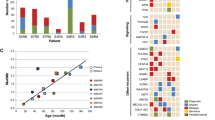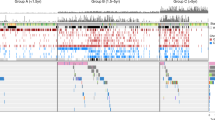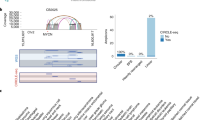Abstract
Whole-genome sequencing detected structural rearrangements of TERT in 17 of 75 high-stage neuroblastomas, with five cases resulting from chromothripsis. Rearrangements were associated with increased TERT expression and targeted regions immediately up- and downstream of TERT, positioning a super-enhancer close to the breakpoints in seven cases. TERT rearrangements (23%), ATRX deletions (11%) and MYCN amplifications (37%) identify three almost non-overlapping groups of high-stage neuroblastoma, each associated with very poor prognosis.
This is a preview of subscription content, access via your institution
Access options
Subscribe to this journal
Receive 12 print issues and online access
$209.00 per year
only $17.42 per issue
Buy this article
- Purchase on Springer Link
- Instant access to full article PDF
Prices may be subject to local taxes which are calculated during checkout


Similar content being viewed by others
References
Molenaar, J.J. et al. Nature 483, 589–593 (2012).
Cheung, N.K. et al. J. Am. Med. Assoc. 307, 1062–1071 (2012).
Pugh, T.J. et al. Nat. Genet. 45, 279–284 (2013).
Sausen, M. et al. Nat. Genet. 45, 12–17 (2013).
Heaphy, C.M. et al. Science 333, 425 (2011).
Huang, F.W. et al. Science 339, 957–959 (2013).
Horn, S. et al. Science 339, 959–961 (2013).
Davis, C.F. et al. Cancer Cell 26, 319–330 (2014).
Bell, R.J.A. et al. Science 348, 1036–1039 (2015).
Lindner, S. et al. Biomed. Rep. 4, 443–446 (2015).
Chipumuro, E. et al. Cell 159, 1126–1139 (2014).
Roadmap Epigenomics Consortium. Nature 518, 317–330 (2015).
Zhao, Y., Wang, S., Popova, E.Y., Grigoryev, S.A. & Zhu, J. Genes Chromosom. Cancer 48, 963–974 (2009).
Killela, P.J. et al. Proc. Natl. Acad. Sci. USA 110, 6021–6026 (2013).
Eckel-Passow, J.E. et al. N. Engl. J. Med. 372, 2499–2508 (2015).
Zhao, Y., Cheng, D., Wang, S. & Zhu, J. Nucleic Acids Res. 42, 10385–10398 (2014).
Acknowledgements
This study was supported by grants from the Villa Joep Foundation, the Children Cancer-Free Foundation (KIKA) and the KWF/Netherlands Cancer Foundation and by a European Union European Research Council (ERC) Advanced grant to R. Versteeg.
Author information
Authors and Affiliations
Contributions
L.J.V., J.K., J.J.M. and R. Versteeg designed the study and prepared the manuscript. L.J.V., N.E.H. and P.v.S. performed experiments. J.K., D.A.Z., R. Volckmann and L.J.V. analyzed data. G.A.M.T. and M.M.v.N. contributed patient material. R.E.G. provided enhancer data.
Corresponding author
Ethics declarations
Competing interests
The authors declare no competing financial interests.
Supplementary information
Supplementary Text and Figures
Supplementary Figures 1–8. (PDF 6950 kb)
Supplementary Table 1
Clinical information on the patients. (XLSX 20 kb)
Supplementary Table 2
Breakpoint analysis of TERT rearrangements. (XLSX 13 kb)
Supplementary Table 3
Enhancer enrichment simulation on 12 random locations. (XLSX 12 kb)
Supplementary Table 4
Cox proportional hazard analysis for MYCN, TERT and ATRX events. (XLSX 11 kb)
Supplementary Table 5
Primers used for RT-PCR. (XLSX 11 kb)
Rights and permissions
About this article
Cite this article
Valentijn, L., Koster, J., Zwijnenburg, D. et al. TERT rearrangements are frequent in neuroblastoma and identify aggressive tumors. Nat Genet 47, 1411–1414 (2015). https://doi.org/10.1038/ng.3438
Received:
Accepted:
Published:
Issue Date:
DOI: https://doi.org/10.1038/ng.3438
This article is cited by
-
Survival Benefit of Myeloablative Therapy with Autologous Stem Cell Transplantation in High-Risk Neuroblastoma: A Systematic Literature Review
Targeted Oncology (2024)
-
Superenhancers as master gene regulators and novel therapeutic targets in brain tumors
Experimental & Molecular Medicine (2023)
-
MYCN amplification, TERT rearrangements and ATRX mutations in neuroblastoma: clinicopathological correlates- an Indian perspective
Virchows Archiv (2023)
-
Neural crest-related NXPH1/α-NRXN signaling opposes neuroblastoma malignancy by inhibiting organotropic metastasis
Oncogene (2023)
-
Clonal evolution during metastatic spread in high-risk neuroblastoma
Nature Genetics (2023)



